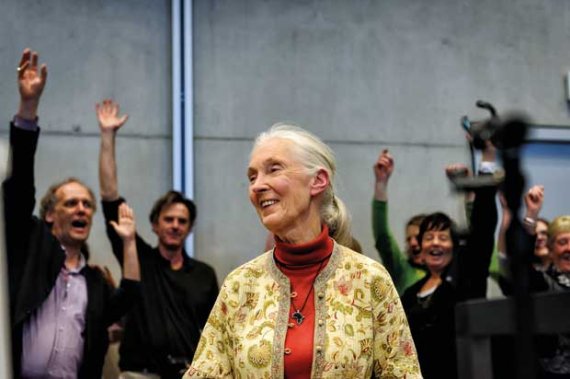As a child Jane Goodall loved the animals and nature around her family home in England. A book about Tarzan aroused her interest in Africa. Later a combination of determination and good luck brought Goodall to the Gombe Stream National Park in Tanzania, where she embarked on the chimpanzee research which would make her famous. She discovered that these primates use tools, hunt smaller apes and even wage war of a kind.In her own words, Goodall lived in paradise in Gombe. That is, until she realized how fast the chimpanzee’s habitat was disappearing. At that point she decided to put her research project behind her and dedicate herself to the battle to save ecosystems and biodiversity. To this end she travels the world 300 days a year. In an effort to impress upon people the important of this battle, she takes the readers of her most recent book Seeds of Hope on a journey through the plant kingdom. Resource talked to Goodall a few days before her lecture to a packed audience in Orion.
With the Jane Goodall Institute you fight the disappearance of nature reserves, especially in Africa. How did this start? ‘Our programme started when I flew over the Gombe National Park in 1991. I knew of course that deforestation was going on outside the park, but I was not prepared to see bare hills where it was once all forest. In places which had been chimp habitat, I now saw exhausted farmland with more people living on it than the land could support.’
Did you connect the destruction of habitats with poverty at the time? ‘I certainly did. Combatting poverty and education are the key to solving this problem. I realized at the time that we could not save the chimpanzees in the rain forest if the people around them were finding it so difficult to survive. So we work with villagers to protect the rainforest. In consultation with them we introduced changes there, such as microcredits and the idea of keeping girls at school longer. In the end this paid off. The locals learned to trust us and they left land alone around the park to allow it to regenerate.’
Besides poverty you indicate other systematic problems which aggravate the destruction of nature. ‘At present, indeed, we are seeing three big problems. The first of these is extreme poverty, which causes people to cut down the last tree to make sure there is food and fuel for themselves and their families. The second – and much more difficult – problem is the greed and selfishness of people who possess more than they need. Lastly, there is population growth, a subject which many nature conservation organizations don’t want to talk about because it is politically sensitive. But we do talk about it in African villages, and we never meet resistance there. It is truly terrifying to see how many children they have. People always say then, ‘it is their culture to have so many children’. But cultures change and at a time like this, they need to, too.’
In your book Seeds of Hope you strongly oppose the use of GMOs. Louise Fresco, soon to be chair of Wageningen UR, argued cautiously in favour of limited admission of GMOs in Science last year. She said higher agricultural yields per hectare will help relieve the pressure on natural ecosystems. Why is Fresco wrong, in your view? ‘I don’t say she is wrong. In the book I am only talking about the science of actually changing plants: the way in which the gene is inserted into them and the long-term effects that has on the environment and possibly on human health. I call for careful thought to be given to these long-term effects.’
And yet at a recent debate in Wageningen both supporters and critics agreed that there is now no evidence that GMOs are dangerous to humans and animals. ‘They can’t say that. There is so much evidence for it and I lined it all up. You can see those effects on all the animals that have been tested, certainly over a longer period of time. These are facts and because this is not my subject I got these facts checked by experts in this field.’
In Seeds of Hope you describe how your childhood out in the fresh air and among animals gave you a lasting love of nature. Do you think this kind of childhood is more unusual now that children are continuously exposed to the internet, games computers and smartphones? ‘A childhood like mine is already more unusual and that is very worrying. If you have never had the chance to relate to nature and know nothing about it, you won’t care about it either. One of the aims of our youth organization Roots and Shoots is to get children out of doors. And if that is not possible, because they live in an inner city for instance, we want to bring nature into the classroom.’
In Wageningen you will be talking to an audience full of ‘green’ students. What is your most important advice to those who want to contribute to a better world? ‘That depends on the individual student, and what their passion is. In any case, make sure you get involved in something you care about, not something you have been told to care about. One piece of advice for everybody would be to spend a bit of time thinking about the consequences of small everyday choices: what we buy, what we wear, and how it is made. We should ask ourselves whether a product harms the environment, whether animals have suffered to produce it, and what effect it has on our health. As one individual such a choice may not seem to make a difference. But we are not just one person, but one of billions. If we get billions of people making ethical choices we start moving in the right direction.’

